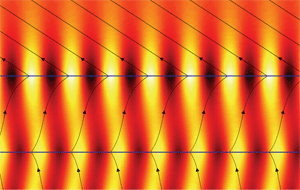Ability to predict nanometer structures’ effect on light waves would let engineers create new measurement, energy systems
A way to predict the behavior of evanescent light waves during nanoscale radiation heat transfer has been discovered by researchers at the Georgia Institute of Technology in Atlanta. The technique could allow designers to reliably create nanoscale electromechanical systems (NEMS) and employ nanotechnologies for such things as solar thermal energy devices.

Waves of electromagnetic energy are seen passing through a vacuum between two plates of silicon carbide 100 nanometers apart, one of which is at an elevated temperature. The lines represent the energy stream, bending the light as it is pushed through the small gap. (Photo: Georgia Institute of Technology)
Evanescent waves are unstable waves produced when light encounters nanoscale features that disrupt its wavelength. Zhuomin Zhang, a lead researcher on the project and a professor in the Woodruff School of Mechanical Engineering, says the discovery provides fundamental information to determine things like the size of and distance between plates when using nanoscale radiation heat transfer. Being able to control these effects would allow energy to be produced by radiating photons of light between two surfaces as close as 10 nm, smaller than the wavelength of the light.
Key to the breakthrough was following the direction of the electromagnetic energy flow (Poynting vector) rather than photon direction to predict behavior, using classic electrodynamics instead of quantum mechanics to explain the behavior of the waves, and predicting the photons’ energy propagation rather than their actual movement.
Since Planck’s law does not apply at the nanoscale, researchers had to pinpoint differences with classical electrodynamics. They observed that, instead of normal straight-line radiation, light would bend as protons tunneled through the vacuum in between two surfaces nanometers apart.
The team also noticed that the evanescent waves were separating during this thermal process, allowing them to visualize and predict the energy path of the waves. Understanding this behavior is critical for designing many nanodevice-based system, among them nearfield thermophotovoltaic systems and nanoscale imaging based on thermal radiation STM and scanning photon-tunneling microscopy.
For further information, visit the Nanoscale Thermal Radiation Laboratory’s Web site, http://www.me.gatech.edu/~zzhang/, or call Zhuomin Zhang at 404-385-4225 or e-mail zhuomin.zhang@me.gatech.edu.
Richard Comerford
Advertisement
Learn more about Georgia Institute of Technolog





